Stakeholder Management at Unilever: Strategies, Impact, and Analysis
VerifiedAdded on 2023/06/11
|25
|5642
|360
Essay
AI Summary
This essay explores stakeholder management within Unilever, a multinational fast-moving consumer goods company. It identifies key stakeholders, including management, employees, governments, financial institutions, suppliers, logistics chains, e-commerce companies, social networking websites, investors, marketing companies, competitors and customers, and examines their impact on Unilever's operations. The essay reviews stakeholder theory and stakeholder management theory, emphasizing the importance of balancing conflicting stakeholder interests for sustainable growth. It also discusses the development of an effective stakeholder communication plan, engagement strategies with various stakeholders like governments, NGOs, suppliers, and customers, and the use of social networking platforms in project implementation. The analysis highlights the critical role of stakeholder management in Unilever's market leadership and growth, especially in the context of its corporate social responsibilities and global presence. Desklib provides access to similar past papers and solved assignments for students.
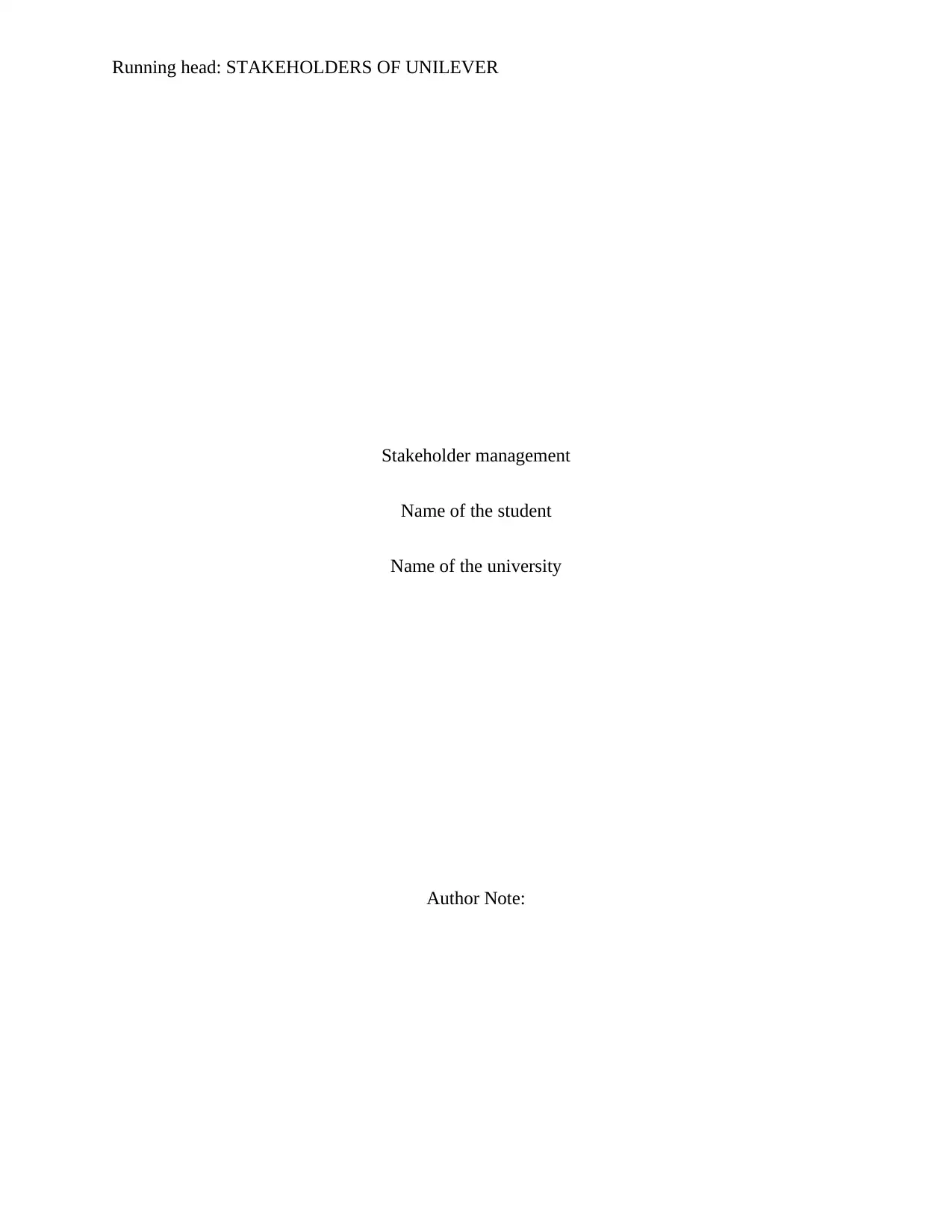
Running head: STAKEHOLDERS OF UNILEVER
Stakeholder management
Name of the student
Name of the university
Author Note:
Stakeholder management
Name of the student
Name of the university
Author Note:
Paraphrase This Document
Need a fresh take? Get an instant paraphrase of this document with our AI Paraphraser
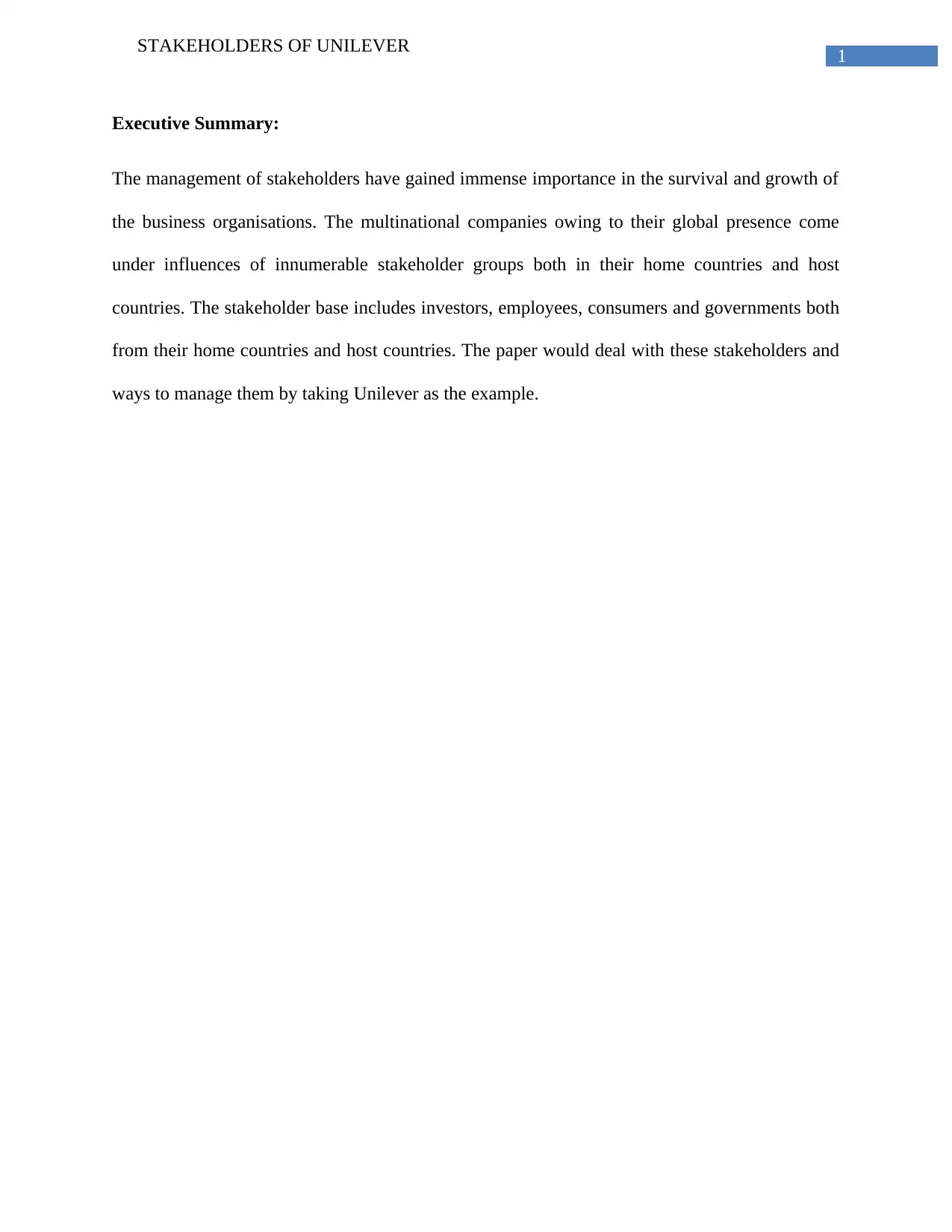
1
STAKEHOLDERS OF UNILEVER
Executive Summary:
The management of stakeholders have gained immense importance in the survival and growth of
the business organisations. The multinational companies owing to their global presence come
under influences of innumerable stakeholder groups both in their home countries and host
countries. The stakeholder base includes investors, employees, consumers and governments both
from their home countries and host countries. The paper would deal with these stakeholders and
ways to manage them by taking Unilever as the example.
STAKEHOLDERS OF UNILEVER
Executive Summary:
The management of stakeholders have gained immense importance in the survival and growth of
the business organisations. The multinational companies owing to their global presence come
under influences of innumerable stakeholder groups both in their home countries and host
countries. The stakeholder base includes investors, employees, consumers and governments both
from their home countries and host countries. The paper would deal with these stakeholders and
ways to manage them by taking Unilever as the example.
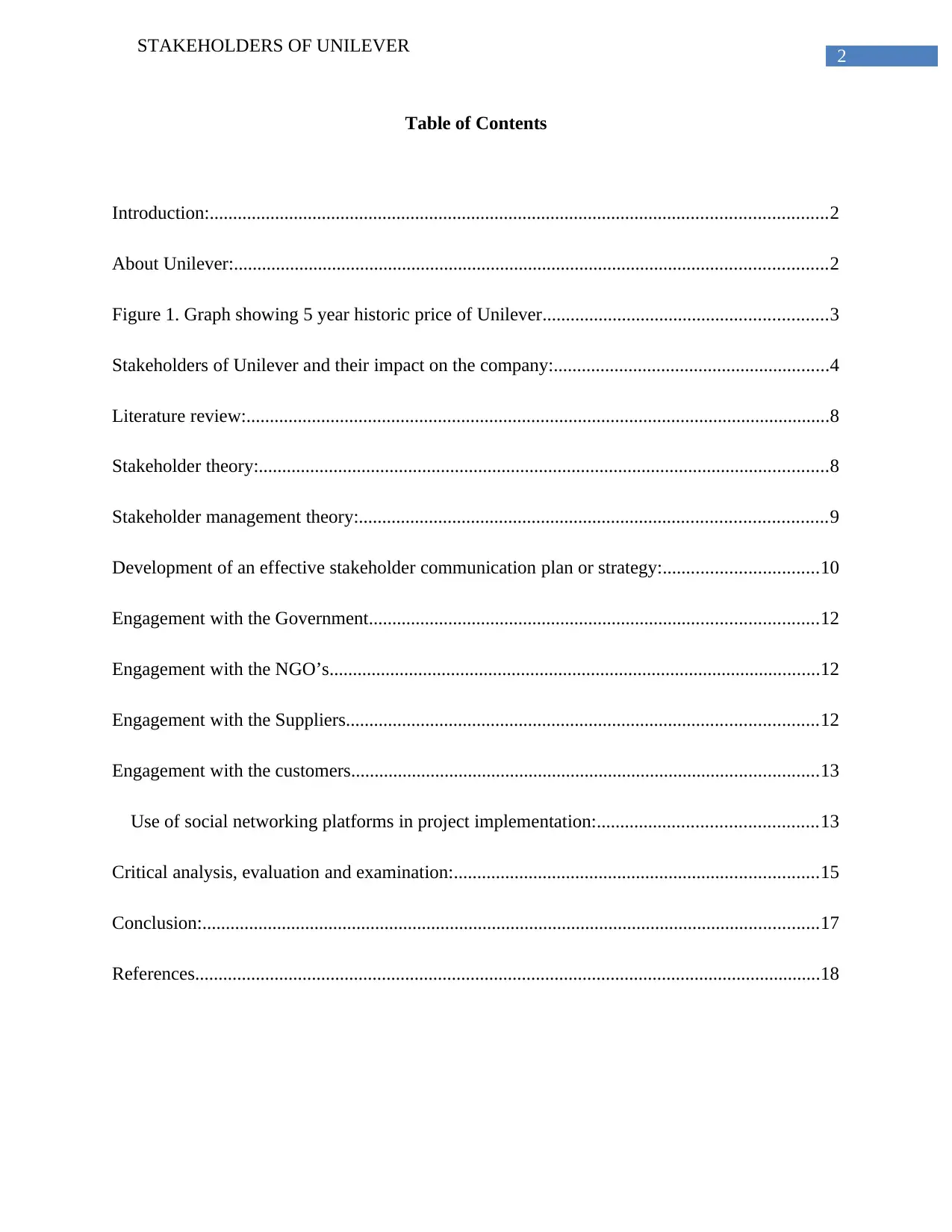
2
STAKEHOLDERS OF UNILEVER
Table of Contents
Introduction:....................................................................................................................................2
About Unilever:...............................................................................................................................2
Figure 1. Graph showing 5 year historic price of Unilever.............................................................3
Stakeholders of Unilever and their impact on the company:...........................................................4
Literature review:.............................................................................................................................8
Stakeholder theory:..........................................................................................................................8
Stakeholder management theory:....................................................................................................9
Development of an effective stakeholder communication plan or strategy:.................................10
Engagement with the Government................................................................................................12
Engagement with the NGO’s.........................................................................................................12
Engagement with the Suppliers.....................................................................................................12
Engagement with the customers....................................................................................................13
Use of social networking platforms in project implementation:...............................................13
Critical analysis, evaluation and examination:..............................................................................15
Conclusion:....................................................................................................................................17
References......................................................................................................................................18
STAKEHOLDERS OF UNILEVER
Table of Contents
Introduction:....................................................................................................................................2
About Unilever:...............................................................................................................................2
Figure 1. Graph showing 5 year historic price of Unilever.............................................................3
Stakeholders of Unilever and their impact on the company:...........................................................4
Literature review:.............................................................................................................................8
Stakeholder theory:..........................................................................................................................8
Stakeholder management theory:....................................................................................................9
Development of an effective stakeholder communication plan or strategy:.................................10
Engagement with the Government................................................................................................12
Engagement with the NGO’s.........................................................................................................12
Engagement with the Suppliers.....................................................................................................12
Engagement with the customers....................................................................................................13
Use of social networking platforms in project implementation:...............................................13
Critical analysis, evaluation and examination:..............................................................................15
Conclusion:....................................................................................................................................17
References......................................................................................................................................18
⊘ This is a preview!⊘
Do you want full access?
Subscribe today to unlock all pages.

Trusted by 1+ million students worldwide
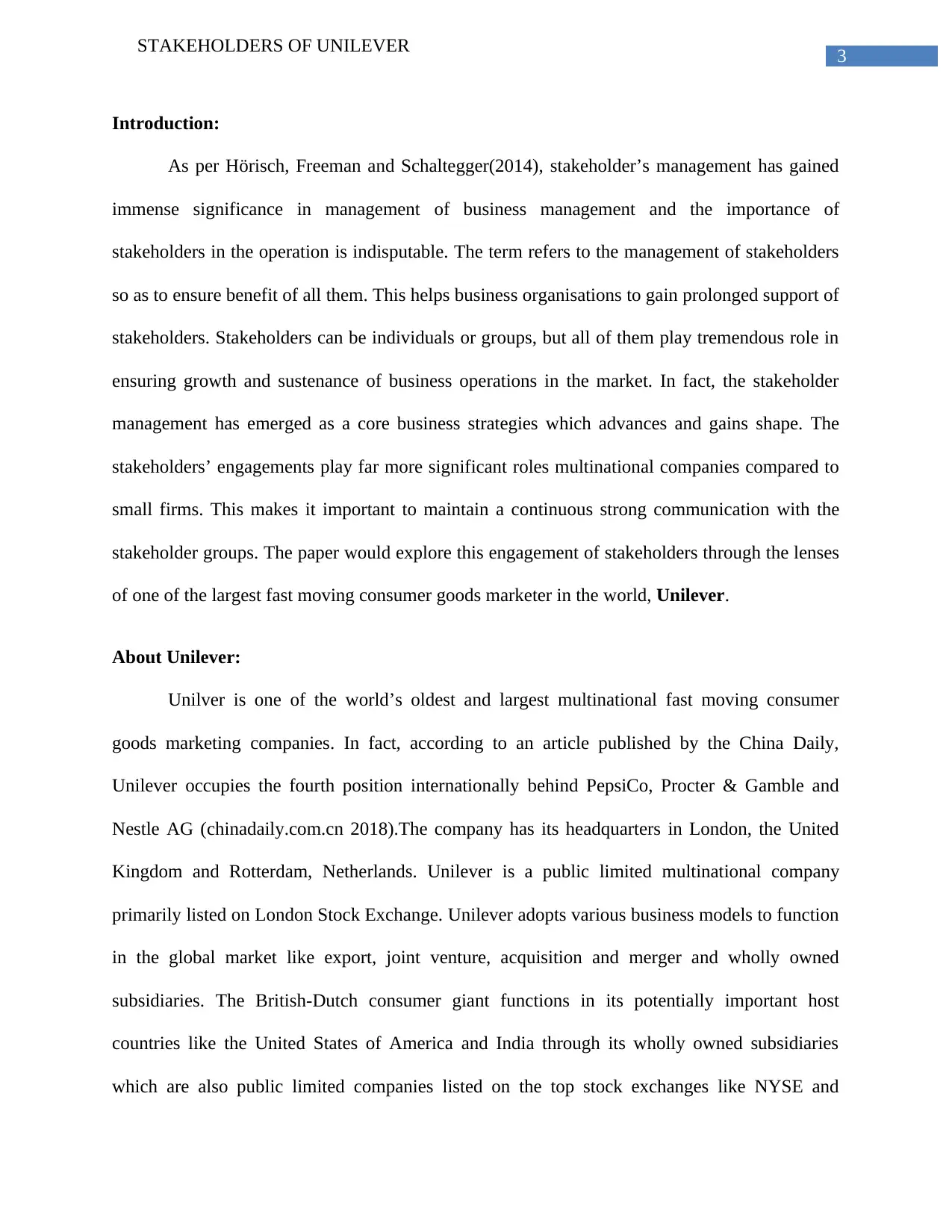
3
STAKEHOLDERS OF UNILEVER
Introduction:
As per Hörisch, Freeman and Schaltegger(2014), stakeholder’s management has gained
immense significance in management of business management and the importance of
stakeholders in the operation is indisputable. The term refers to the management of stakeholders
so as to ensure benefit of all them. This helps business organisations to gain prolonged support of
stakeholders. Stakeholders can be individuals or groups, but all of them play tremendous role in
ensuring growth and sustenance of business operations in the market. In fact, the stakeholder
management has emerged as a core business strategies which advances and gains shape. The
stakeholders’ engagements play far more significant roles multinational companies compared to
small firms. This makes it important to maintain a continuous strong communication with the
stakeholder groups. The paper would explore this engagement of stakeholders through the lenses
of one of the largest fast moving consumer goods marketer in the world, Unilever.
About Unilever:
Unilver is one of the world’s oldest and largest multinational fast moving consumer
goods marketing companies. In fact, according to an article published by the China Daily,
Unilever occupies the fourth position internationally behind PepsiCo, Procter & Gamble and
Nestle AG (chinadaily.com.cn 2018).The company has its headquarters in London, the United
Kingdom and Rotterdam, Netherlands. Unilever is a public limited multinational company
primarily listed on London Stock Exchange. Unilever adopts various business models to function
in the global market like export, joint venture, acquisition and merger and wholly owned
subsidiaries. The British-Dutch consumer giant functions in its potentially important host
countries like the United States of America and India through its wholly owned subsidiaries
which are also public limited companies listed on the top stock exchanges like NYSE and
STAKEHOLDERS OF UNILEVER
Introduction:
As per Hörisch, Freeman and Schaltegger(2014), stakeholder’s management has gained
immense significance in management of business management and the importance of
stakeholders in the operation is indisputable. The term refers to the management of stakeholders
so as to ensure benefit of all them. This helps business organisations to gain prolonged support of
stakeholders. Stakeholders can be individuals or groups, but all of them play tremendous role in
ensuring growth and sustenance of business operations in the market. In fact, the stakeholder
management has emerged as a core business strategies which advances and gains shape. The
stakeholders’ engagements play far more significant roles multinational companies compared to
small firms. This makes it important to maintain a continuous strong communication with the
stakeholder groups. The paper would explore this engagement of stakeholders through the lenses
of one of the largest fast moving consumer goods marketer in the world, Unilever.
About Unilever:
Unilver is one of the world’s oldest and largest multinational fast moving consumer
goods marketing companies. In fact, according to an article published by the China Daily,
Unilever occupies the fourth position internationally behind PepsiCo, Procter & Gamble and
Nestle AG (chinadaily.com.cn 2018).The company has its headquarters in London, the United
Kingdom and Rotterdam, Netherlands. Unilever is a public limited multinational company
primarily listed on London Stock Exchange. Unilever adopts various business models to function
in the global market like export, joint venture, acquisition and merger and wholly owned
subsidiaries. The British-Dutch consumer giant functions in its potentially important host
countries like the United States of America and India through its wholly owned subsidiaries
which are also public limited companies listed on the top stock exchanges like NYSE and
Paraphrase This Document
Need a fresh take? Get an instant paraphrase of this document with our AI Paraphraser
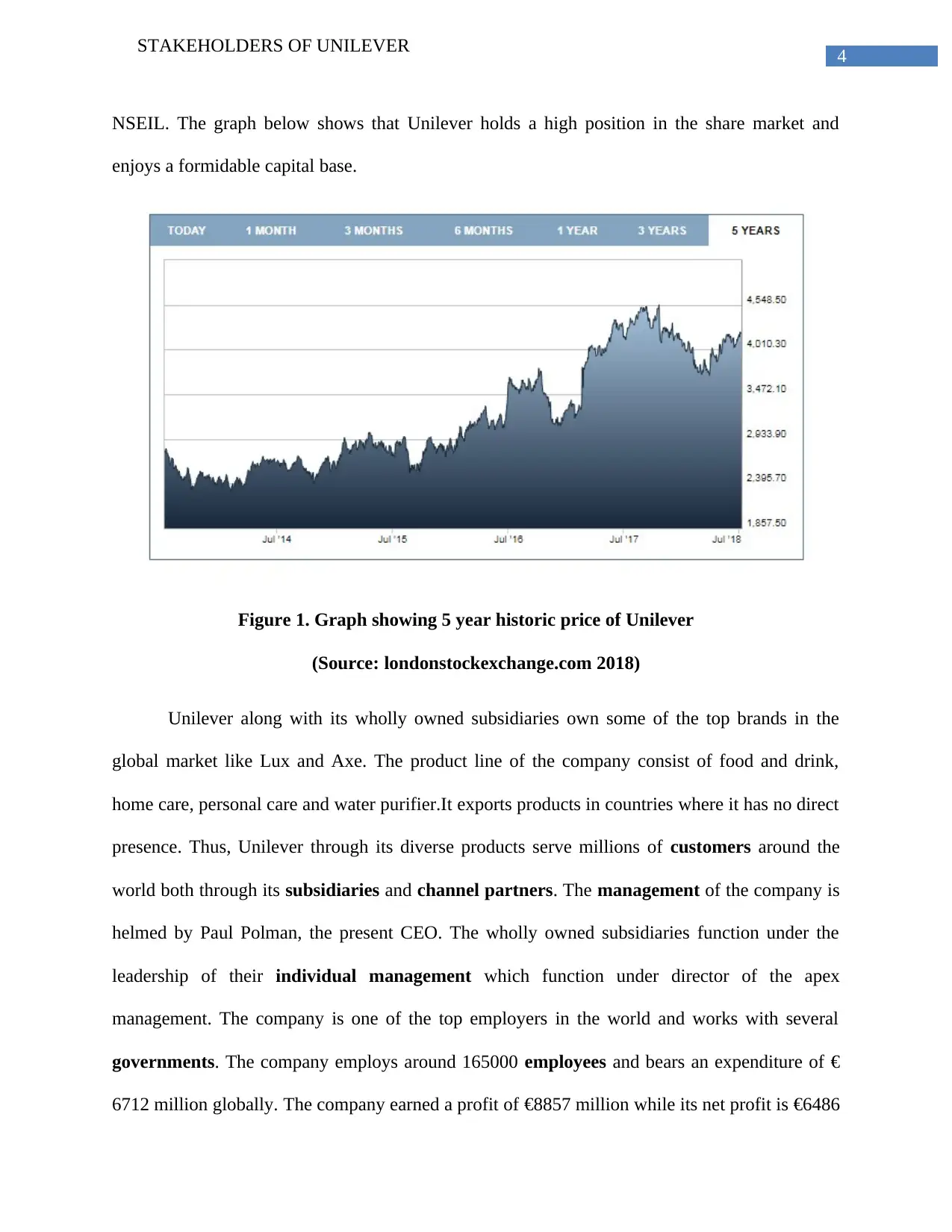
4
STAKEHOLDERS OF UNILEVER
NSEIL. The graph below shows that Unilever holds a high position in the share market and
enjoys a formidable capital base.
Figure 1. Graph showing 5 year historic price of Unilever
(Source: londonstockexchange.com 2018)
Unilever along with its wholly owned subsidiaries own some of the top brands in the
global market like Lux and Axe. The product line of the company consist of food and drink,
home care, personal care and water purifier.It exports products in countries where it has no direct
presence. Thus, Unilever through its diverse products serve millions of customers around the
world both through its subsidiaries and channel partners. The management of the company is
helmed by Paul Polman, the present CEO. The wholly owned subsidiaries function under the
leadership of their individual management which function under director of the apex
management. The company is one of the top employers in the world and works with several
governments. The company employs around 165000 employees and bears an expenditure of €
6712 million globally. The company earned a profit of €8857 million while its net profit is €6486
STAKEHOLDERS OF UNILEVER
NSEIL. The graph below shows that Unilever holds a high position in the share market and
enjoys a formidable capital base.
Figure 1. Graph showing 5 year historic price of Unilever
(Source: londonstockexchange.com 2018)
Unilever along with its wholly owned subsidiaries own some of the top brands in the
global market like Lux and Axe. The product line of the company consist of food and drink,
home care, personal care and water purifier.It exports products in countries where it has no direct
presence. Thus, Unilever through its diverse products serve millions of customers around the
world both through its subsidiaries and channel partners. The management of the company is
helmed by Paul Polman, the present CEO. The wholly owned subsidiaries function under the
leadership of their individual management which function under director of the apex
management. The company is one of the top employers in the world and works with several
governments. The company employs around 165000 employees and bears an expenditure of €
6712 million globally. The company earned a profit of €8857 million while its net profit is €6486
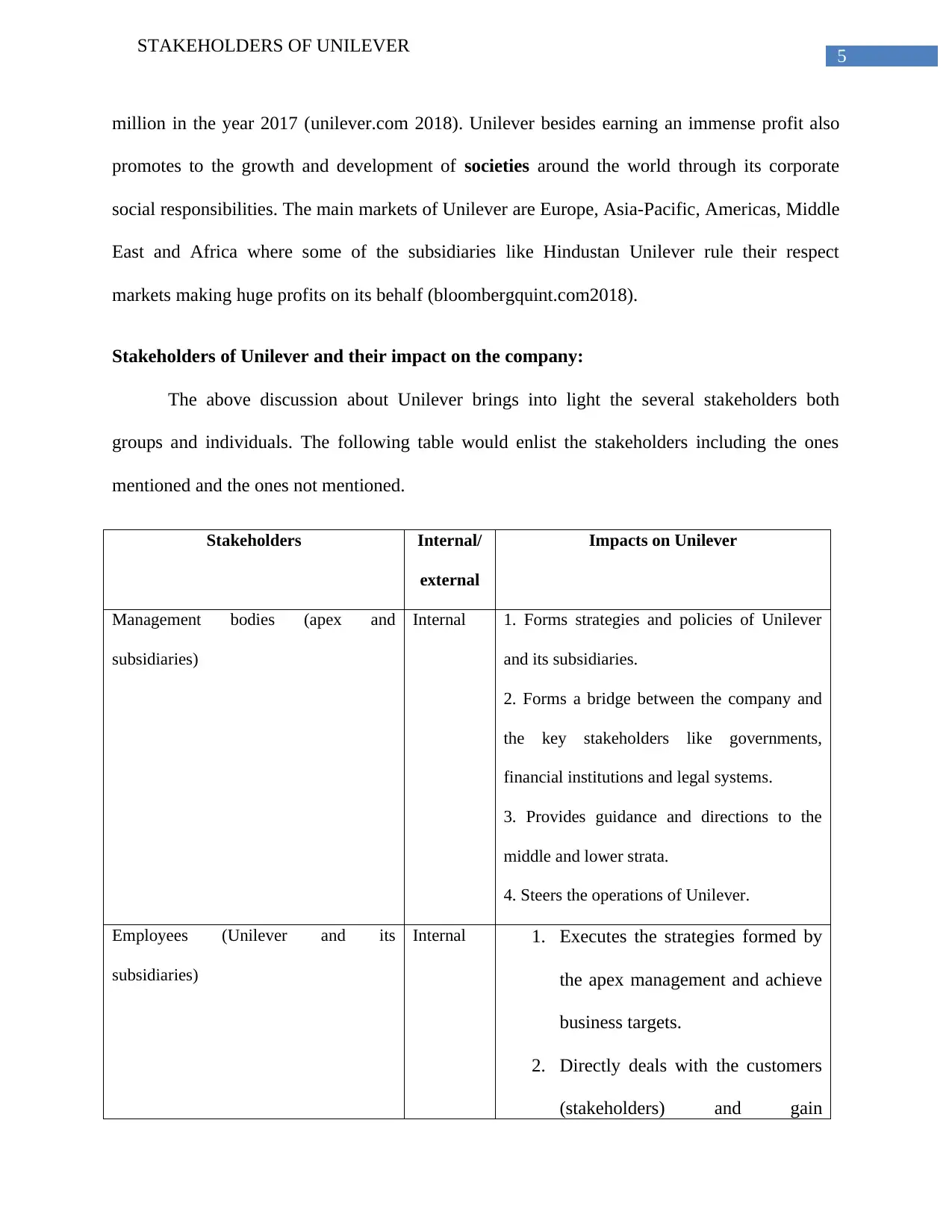
5
STAKEHOLDERS OF UNILEVER
million in the year 2017 (unilever.com 2018). Unilever besides earning an immense profit also
promotes to the growth and development of societies around the world through its corporate
social responsibilities. The main markets of Unilever are Europe, Asia-Pacific, Americas, Middle
East and Africa where some of the subsidiaries like Hindustan Unilever rule their respect
markets making huge profits on its behalf (bloombergquint.com2018).
Stakeholders of Unilever and their impact on the company:
The above discussion about Unilever brings into light the several stakeholders both
groups and individuals. The following table would enlist the stakeholders including the ones
mentioned and the ones not mentioned.
Stakeholders Internal/
external
Impacts on Unilever
Management bodies (apex and
subsidiaries)
Internal 1. Forms strategies and policies of Unilever
and its subsidiaries.
2. Forms a bridge between the company and
the key stakeholders like governments,
financial institutions and legal systems.
3. Provides guidance and directions to the
middle and lower strata.
4. Steers the operations of Unilever.
Employees (Unilever and its
subsidiaries)
Internal 1. Executes the strategies formed by
the apex management and achieve
business targets.
2. Directly deals with the customers
(stakeholders) and gain
STAKEHOLDERS OF UNILEVER
million in the year 2017 (unilever.com 2018). Unilever besides earning an immense profit also
promotes to the growth and development of societies around the world through its corporate
social responsibilities. The main markets of Unilever are Europe, Asia-Pacific, Americas, Middle
East and Africa where some of the subsidiaries like Hindustan Unilever rule their respect
markets making huge profits on its behalf (bloombergquint.com2018).
Stakeholders of Unilever and their impact on the company:
The above discussion about Unilever brings into light the several stakeholders both
groups and individuals. The following table would enlist the stakeholders including the ones
mentioned and the ones not mentioned.
Stakeholders Internal/
external
Impacts on Unilever
Management bodies (apex and
subsidiaries)
Internal 1. Forms strategies and policies of Unilever
and its subsidiaries.
2. Forms a bridge between the company and
the key stakeholders like governments,
financial institutions and legal systems.
3. Provides guidance and directions to the
middle and lower strata.
4. Steers the operations of Unilever.
Employees (Unilever and its
subsidiaries)
Internal 1. Executes the strategies formed by
the apex management and achieve
business targets.
2. Directly deals with the customers
(stakeholders) and gain
⊘ This is a preview!⊘
Do you want full access?
Subscribe today to unlock all pages.

Trusted by 1+ million students worldwide
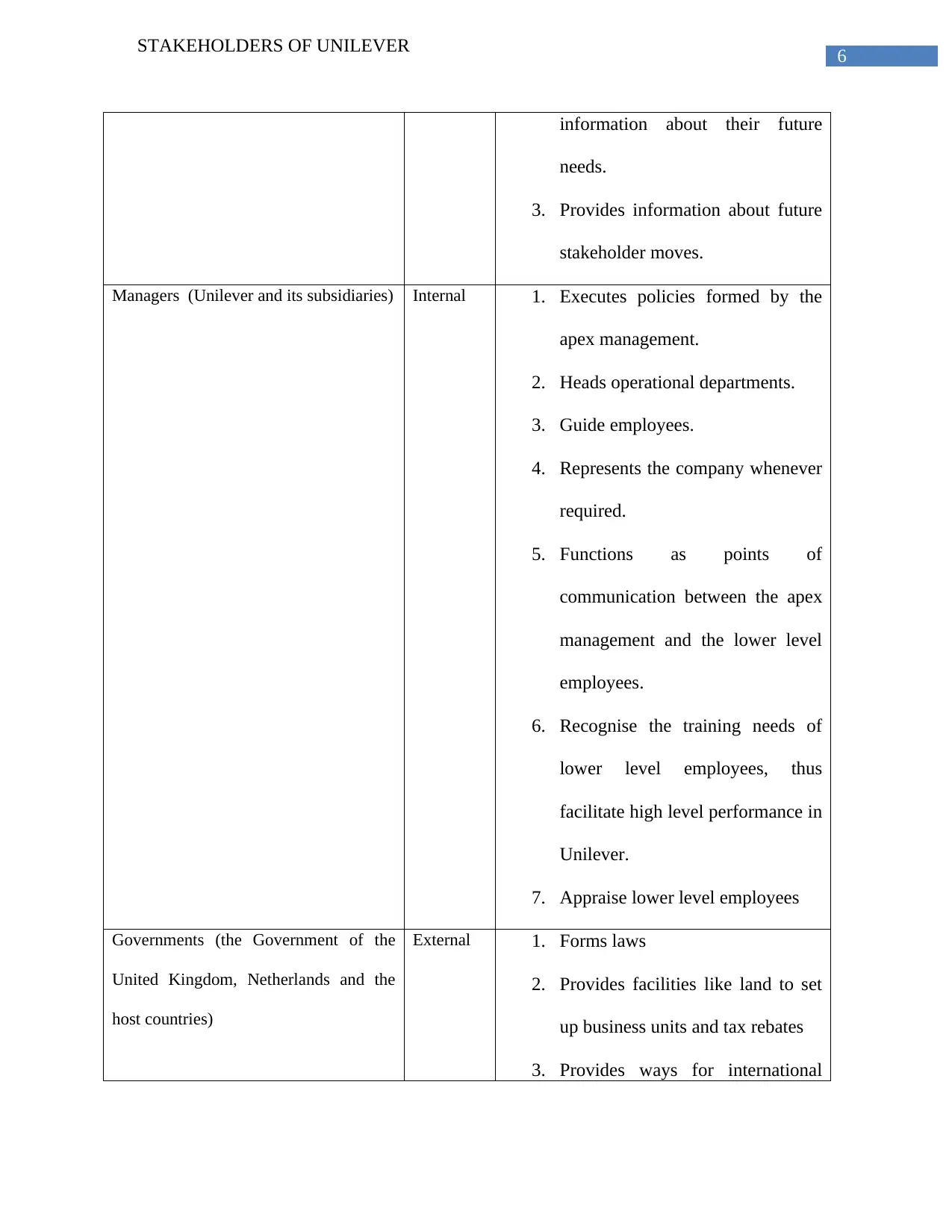
6
STAKEHOLDERS OF UNILEVER
information about their future
needs.
3. Provides information about future
stakeholder moves.
Managers (Unilever and its subsidiaries) Internal 1. Executes policies formed by the
apex management.
2. Heads operational departments.
3. Guide employees.
4. Represents the company whenever
required.
5. Functions as points of
communication between the apex
management and the lower level
employees.
6. Recognise the training needs of
lower level employees, thus
facilitate high level performance in
Unilever.
7. Appraise lower level employees
Governments (the Government of the
United Kingdom, Netherlands and the
host countries)
External 1. Forms laws
2. Provides facilities like land to set
up business units and tax rebates
3. Provides ways for international
STAKEHOLDERS OF UNILEVER
information about their future
needs.
3. Provides information about future
stakeholder moves.
Managers (Unilever and its subsidiaries) Internal 1. Executes policies formed by the
apex management.
2. Heads operational departments.
3. Guide employees.
4. Represents the company whenever
required.
5. Functions as points of
communication between the apex
management and the lower level
employees.
6. Recognise the training needs of
lower level employees, thus
facilitate high level performance in
Unilever.
7. Appraise lower level employees
Governments (the Government of the
United Kingdom, Netherlands and the
host countries)
External 1. Forms laws
2. Provides facilities like land to set
up business units and tax rebates
3. Provides ways for international
Paraphrase This Document
Need a fresh take? Get an instant paraphrase of this document with our AI Paraphraser
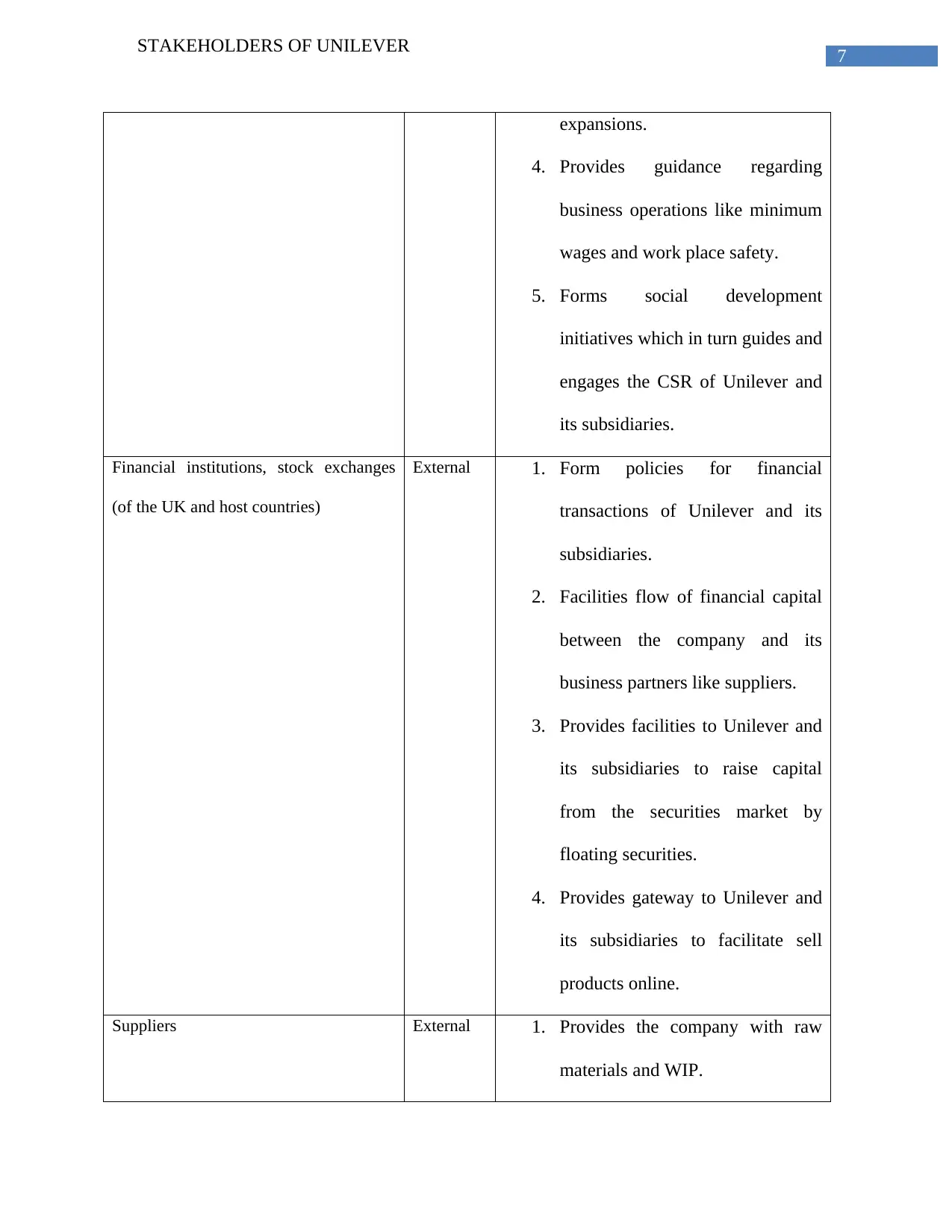
7
STAKEHOLDERS OF UNILEVER
expansions.
4. Provides guidance regarding
business operations like minimum
wages and work place safety.
5. Forms social development
initiatives which in turn guides and
engages the CSR of Unilever and
its subsidiaries.
Financial institutions, stock exchanges
(of the UK and host countries)
External 1. Form policies for financial
transactions of Unilever and its
subsidiaries.
2. Facilities flow of financial capital
between the company and its
business partners like suppliers.
3. Provides facilities to Unilever and
its subsidiaries to raise capital
from the securities market by
floating securities.
4. Provides gateway to Unilever and
its subsidiaries to facilitate sell
products online.
Suppliers External 1. Provides the company with raw
materials and WIP.
STAKEHOLDERS OF UNILEVER
expansions.
4. Provides guidance regarding
business operations like minimum
wages and work place safety.
5. Forms social development
initiatives which in turn guides and
engages the CSR of Unilever and
its subsidiaries.
Financial institutions, stock exchanges
(of the UK and host countries)
External 1. Form policies for financial
transactions of Unilever and its
subsidiaries.
2. Facilities flow of financial capital
between the company and its
business partners like suppliers.
3. Provides facilities to Unilever and
its subsidiaries to raise capital
from the securities market by
floating securities.
4. Provides gateway to Unilever and
its subsidiaries to facilitate sell
products online.
Suppliers External 1. Provides the company with raw
materials and WIP.
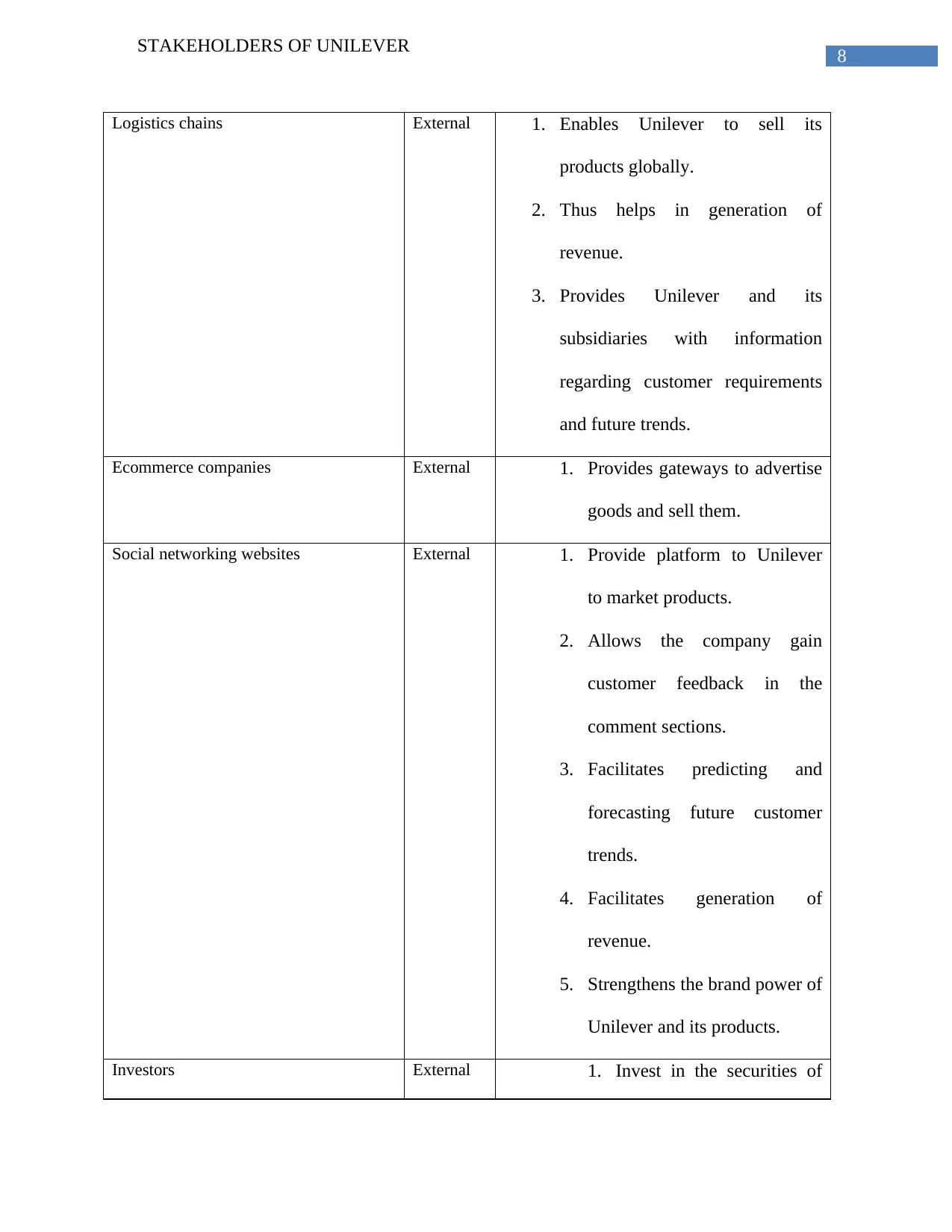
8
STAKEHOLDERS OF UNILEVER
Logistics chains External 1. Enables Unilever to sell its
products globally.
2. Thus helps in generation of
revenue.
3. Provides Unilever and its
subsidiaries with information
regarding customer requirements
and future trends.
Ecommerce companies External 1. Provides gateways to advertise
goods and sell them.
Social networking websites External 1. Provide platform to Unilever
to market products.
2. Allows the company gain
customer feedback in the
comment sections.
3. Facilitates predicting and
forecasting future customer
trends.
4. Facilitates generation of
revenue.
5. Strengthens the brand power of
Unilever and its products.
Investors External 1. Invest in the securities of
STAKEHOLDERS OF UNILEVER
Logistics chains External 1. Enables Unilever to sell its
products globally.
2. Thus helps in generation of
revenue.
3. Provides Unilever and its
subsidiaries with information
regarding customer requirements
and future trends.
Ecommerce companies External 1. Provides gateways to advertise
goods and sell them.
Social networking websites External 1. Provide platform to Unilever
to market products.
2. Allows the company gain
customer feedback in the
comment sections.
3. Facilitates predicting and
forecasting future customer
trends.
4. Facilitates generation of
revenue.
5. Strengthens the brand power of
Unilever and its products.
Investors External 1. Invest in the securities of
⊘ This is a preview!⊘
Do you want full access?
Subscribe today to unlock all pages.

Trusted by 1+ million students worldwide
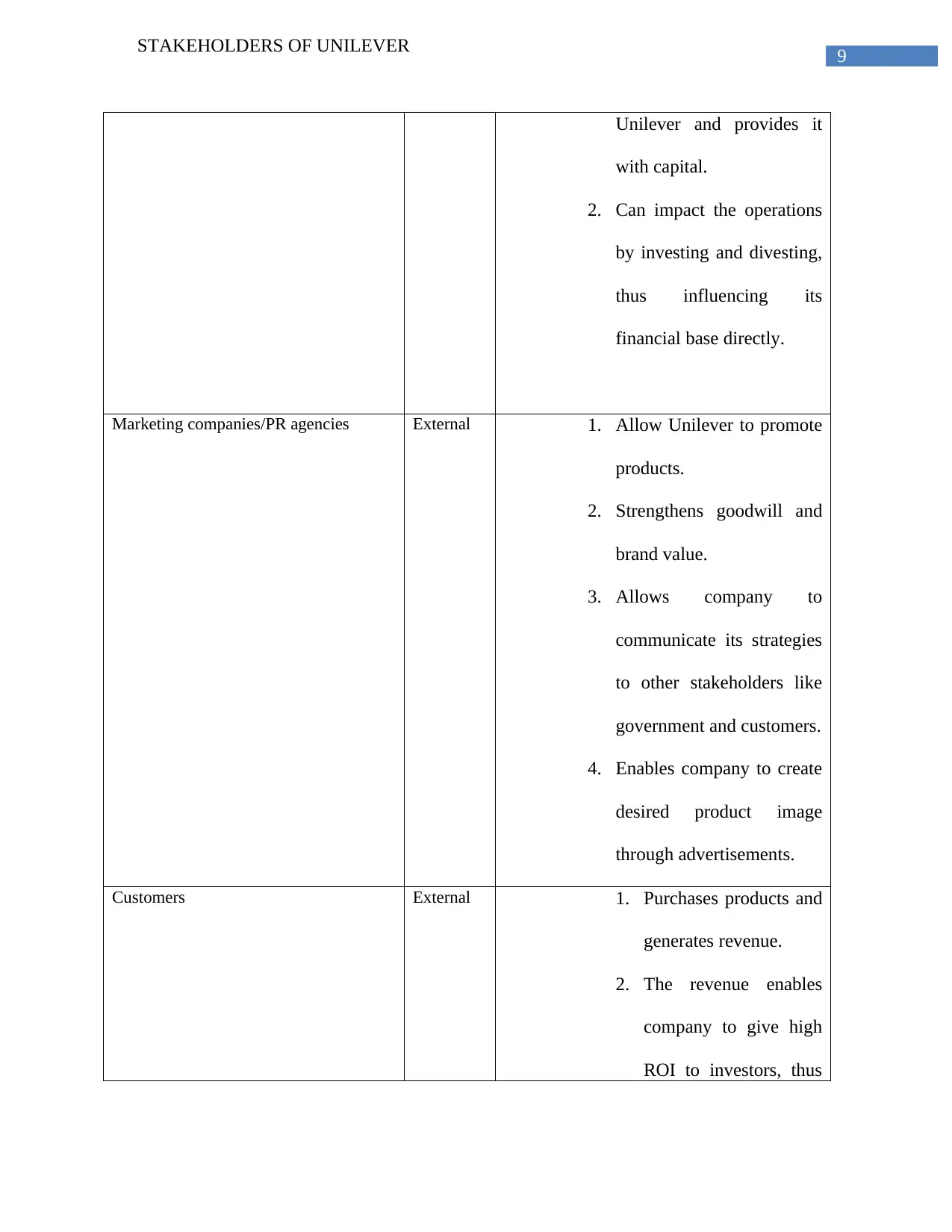
9
STAKEHOLDERS OF UNILEVER
Unilever and provides it
with capital.
2. Can impact the operations
by investing and divesting,
thus influencing its
financial base directly.
Marketing companies/PR agencies External 1. Allow Unilever to promote
products.
2. Strengthens goodwill and
brand value.
3. Allows company to
communicate its strategies
to other stakeholders like
government and customers.
4. Enables company to create
desired product image
through advertisements.
Customers External 1. Purchases products and
generates revenue.
2. The revenue enables
company to give high
ROI to investors, thus
STAKEHOLDERS OF UNILEVER
Unilever and provides it
with capital.
2. Can impact the operations
by investing and divesting,
thus influencing its
financial base directly.
Marketing companies/PR agencies External 1. Allow Unilever to promote
products.
2. Strengthens goodwill and
brand value.
3. Allows company to
communicate its strategies
to other stakeholders like
government and customers.
4. Enables company to create
desired product image
through advertisements.
Customers External 1. Purchases products and
generates revenue.
2. The revenue enables
company to give high
ROI to investors, thus
Paraphrase This Document
Need a fresh take? Get an instant paraphrase of this document with our AI Paraphraser
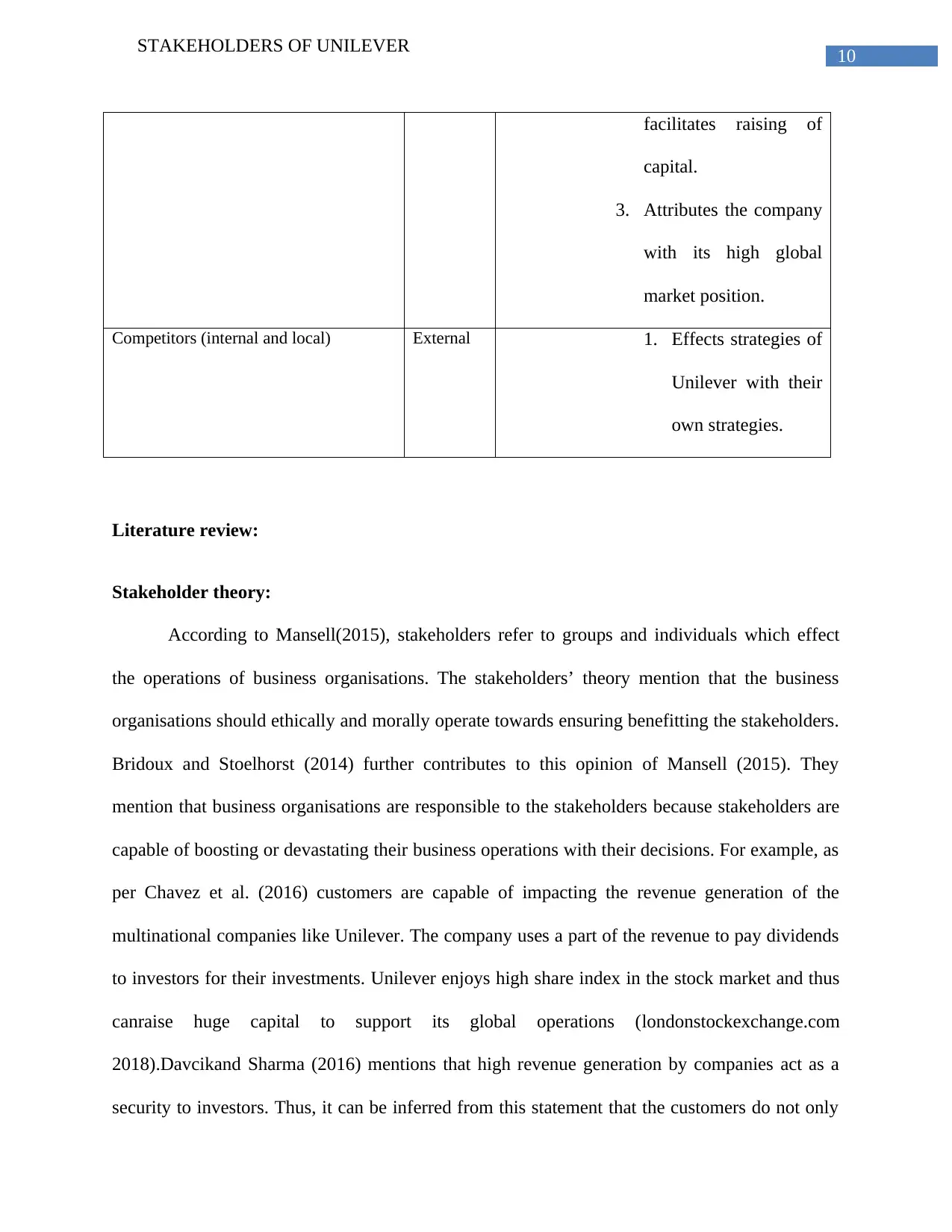
10
STAKEHOLDERS OF UNILEVER
facilitates raising of
capital.
3. Attributes the company
with its high global
market position.
Competitors (internal and local) External 1. Effects strategies of
Unilever with their
own strategies.
Literature review:
Stakeholder theory:
According to Mansell(2015), stakeholders refer to groups and individuals which effect
the operations of business organisations. The stakeholders’ theory mention that the business
organisations should ethically and morally operate towards ensuring benefitting the stakeholders.
Bridoux and Stoelhorst (2014) further contributes to this opinion of Mansell (2015). They
mention that business organisations are responsible to the stakeholders because stakeholders are
capable of boosting or devastating their business operations with their decisions. For example, as
per Chavez et al. (2016) customers are capable of impacting the revenue generation of the
multinational companies like Unilever. The company uses a part of the revenue to pay dividends
to investors for their investments. Unilever enjoys high share index in the stock market and thus
canraise huge capital to support its global operations (londonstockexchange.com
2018).Davcikand Sharma (2016) mentions that high revenue generation by companies act as a
security to investors. Thus, it can be inferred from this statement that the customers do not only
STAKEHOLDERS OF UNILEVER
facilitates raising of
capital.
3. Attributes the company
with its high global
market position.
Competitors (internal and local) External 1. Effects strategies of
Unilever with their
own strategies.
Literature review:
Stakeholder theory:
According to Mansell(2015), stakeholders refer to groups and individuals which effect
the operations of business organisations. The stakeholders’ theory mention that the business
organisations should ethically and morally operate towards ensuring benefitting the stakeholders.
Bridoux and Stoelhorst (2014) further contributes to this opinion of Mansell (2015). They
mention that business organisations are responsible to the stakeholders because stakeholders are
capable of boosting or devastating their business operations with their decisions. For example, as
per Chavez et al. (2016) customers are capable of impacting the revenue generation of the
multinational companies like Unilever. The company uses a part of the revenue to pay dividends
to investors for their investments. Unilever enjoys high share index in the stock market and thus
canraise huge capital to support its global operations (londonstockexchange.com
2018).Davcikand Sharma (2016) mentions that high revenue generation by companies act as a
security to investors. Thus, it can be inferred from this statement that the customers do not only
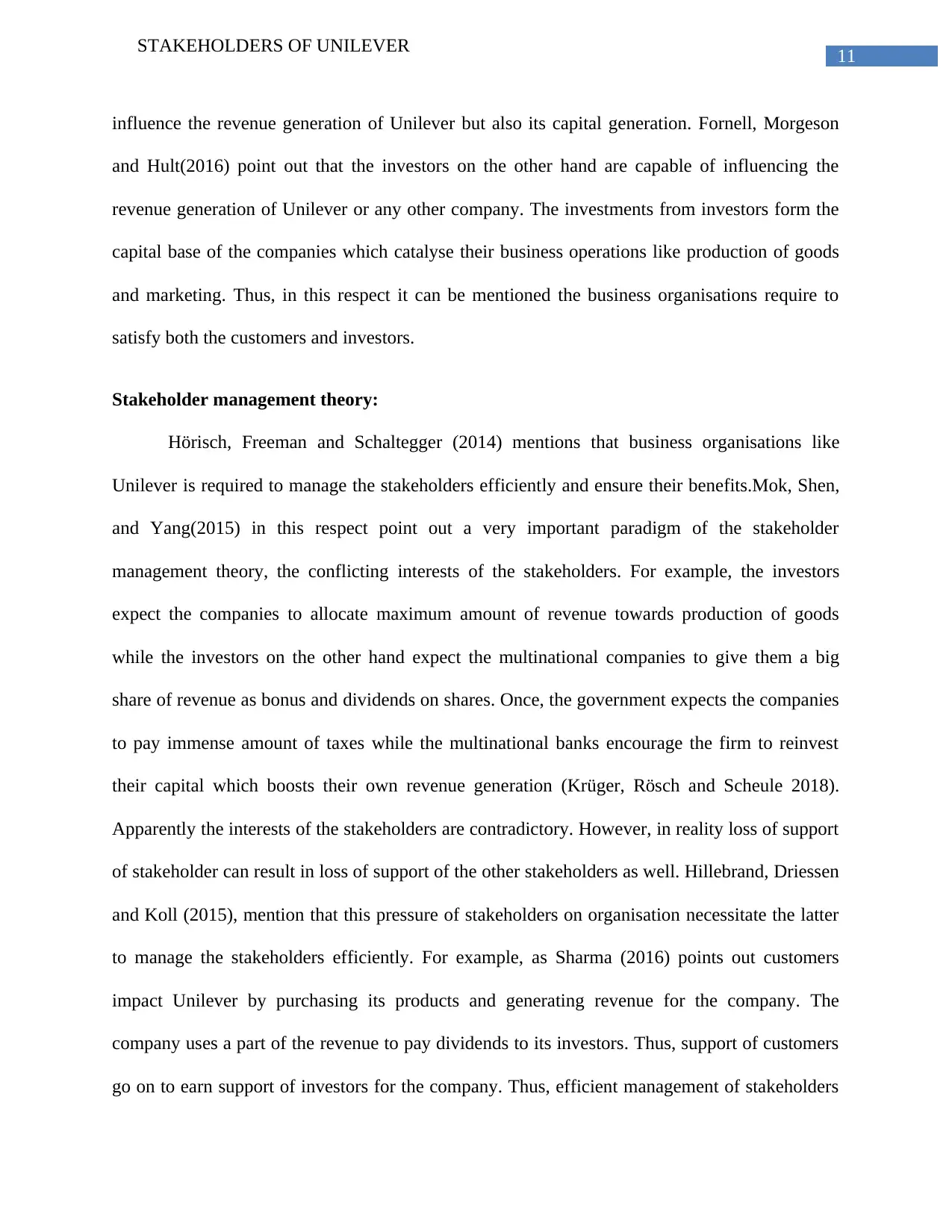
11
STAKEHOLDERS OF UNILEVER
influence the revenue generation of Unilever but also its capital generation. Fornell, Morgeson
and Hult(2016) point out that the investors on the other hand are capable of influencing the
revenue generation of Unilever or any other company. The investments from investors form the
capital base of the companies which catalyse their business operations like production of goods
and marketing. Thus, in this respect it can be mentioned the business organisations require to
satisfy both the customers and investors.
Stakeholder management theory:
Hörisch, Freeman and Schaltegger (2014) mentions that business organisations like
Unilever is required to manage the stakeholders efficiently and ensure their benefits.Mok, Shen,
and Yang(2015) in this respect point out a very important paradigm of the stakeholder
management theory, the conflicting interests of the stakeholders. For example, the investors
expect the companies to allocate maximum amount of revenue towards production of goods
while the investors on the other hand expect the multinational companies to give them a big
share of revenue as bonus and dividends on shares. Once, the government expects the companies
to pay immense amount of taxes while the multinational banks encourage the firm to reinvest
their capital which boosts their own revenue generation (Krüger, Rösch and Scheule 2018).
Apparently the interests of the stakeholders are contradictory. However, in reality loss of support
of stakeholder can result in loss of support of the other stakeholders as well. Hillebrand, Driessen
and Koll (2015), mention that this pressure of stakeholders on organisation necessitate the latter
to manage the stakeholders efficiently. For example, as Sharma (2016) points out customers
impact Unilever by purchasing its products and generating revenue for the company. The
company uses a part of the revenue to pay dividends to its investors. Thus, support of customers
go on to earn support of investors for the company. Thus, efficient management of stakeholders
STAKEHOLDERS OF UNILEVER
influence the revenue generation of Unilever but also its capital generation. Fornell, Morgeson
and Hult(2016) point out that the investors on the other hand are capable of influencing the
revenue generation of Unilever or any other company. The investments from investors form the
capital base of the companies which catalyse their business operations like production of goods
and marketing. Thus, in this respect it can be mentioned the business organisations require to
satisfy both the customers and investors.
Stakeholder management theory:
Hörisch, Freeman and Schaltegger (2014) mentions that business organisations like
Unilever is required to manage the stakeholders efficiently and ensure their benefits.Mok, Shen,
and Yang(2015) in this respect point out a very important paradigm of the stakeholder
management theory, the conflicting interests of the stakeholders. For example, the investors
expect the companies to allocate maximum amount of revenue towards production of goods
while the investors on the other hand expect the multinational companies to give them a big
share of revenue as bonus and dividends on shares. Once, the government expects the companies
to pay immense amount of taxes while the multinational banks encourage the firm to reinvest
their capital which boosts their own revenue generation (Krüger, Rösch and Scheule 2018).
Apparently the interests of the stakeholders are contradictory. However, in reality loss of support
of stakeholder can result in loss of support of the other stakeholders as well. Hillebrand, Driessen
and Koll (2015), mention that this pressure of stakeholders on organisation necessitate the latter
to manage the stakeholders efficiently. For example, as Sharma (2016) points out customers
impact Unilever by purchasing its products and generating revenue for the company. The
company uses a part of the revenue to pay dividends to its investors. Thus, support of customers
go on to earn support of investors for the company. Thus, efficient management of stakeholders
⊘ This is a preview!⊘
Do you want full access?
Subscribe today to unlock all pages.

Trusted by 1+ million students worldwide
1 out of 25
Related Documents
Your All-in-One AI-Powered Toolkit for Academic Success.
+13062052269
info@desklib.com
Available 24*7 on WhatsApp / Email
![[object Object]](/_next/static/media/star-bottom.7253800d.svg)
Unlock your academic potential
Copyright © 2020–2025 A2Z Services. All Rights Reserved. Developed and managed by ZUCOL.





